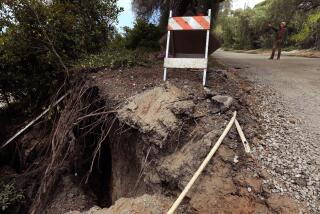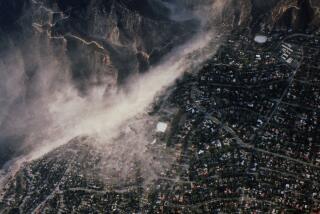Fears of Sinking Soil Stall Subway Effort : Safety: Mining experts consider how best to cope with special construction challenges of the earth.
NORTH HOLLYWOOD — A thin Fiberglas rod driven 45 feet into the ground signaled the warning. The rod had dropped half an inch, marking trouble below, where a giant tunneling machine had forged 40 feet ahead into the fickle soil.
Engineers knew they faced a considerable challenge when construction of the Valley’s first subway line began Feb. 13. But it wasn’t until the rod’s slight drop on April 7 that they realized the troubles were greater than they had foreseen--that the ground was almost continuously collapsing as they excavated the subway tunnel, potentially jeopardizing not only their construction project but buildings and streets above.
Work on the $65.4-million, two-mile project has been at a standstill since, while some of the world’s leading mining experts decide how to tackle the geological phenomenon and officials bicker over who will pay for the extra work.
“There are thousands of ways of doing the job,” said Al Wattson, construction manager of the 11.6-mile segment of the Metro Red Line subway that will stretch from North Hollywood to Hollywood. “It’s partly science and partly art.”
As officials engage in the art of negotiating technique and bills, geologists have been immersed in the science of determining exactly how far the ground has sunk. Thanks to a complex measuring system in which sensitive Fiberglas rods detect the slightest ground movement, they are certain of their calculations and can now use them to prevent buildings and infrastructure from shifting.
“The numbers are very precise,” said Anthony Stirbys, geotechnical coordinator for the Metro Rail construction manager, Parsons-Dillingham.
In a way, building a subway in Los Angeles is a bit like a child’s game at the beach. You cut the top and bottom off an empty tin can and shove it horizontally into the side of a sand dune. What happens? As the can fills with sand at one end and is scooped clean at the other, gravity pulls more sand inside. The result: The surface of the dune drops.
That’s what happened last August in Hollywood, when a portion of Hollywood Boulevard above the new subway tunnel sank almost a foot, potentially compromising the safety of buildings, streets, sewers and utility lines above.
It’s also bad news for excavating a subway in the Valley, where much of the subsoil similarly consists of sand and gravel washed down over thousands of years from the surrounding mountains. The engineers faced with the delicate task of tunneling from North Hollywood to Universal City experienced the same geological phenomenon as they did in Hollywood, though to a far lesser degree.
The Los Angeles tunneling project is posing problems not previously encountered in other American cities such as New York and Chicago, where the hard subterranean rock was comparatively easy to drill and considered to be “more competent,” said Khosrow Bakhtar, a Newport Beach tunneling expert. However, he said similar troubles with subsidence plagued the subway project in London, a city built on clay, and various other mining projects throughout the world.
The soft soils and fractured rocks in both Hollywood and North Hollywood, he said, are “characteristic of the whole Los Angeles Basin from here to China Lake.”
As they began work in the Valley, engineers were initially optimistic that their giant excavating machine would advance eight feet an hour--or as much as 200 feet per day--beneath Lankershim Boulevard. But two months later, after a series of starts and stops, the tunnel had progressed only a total of 216 feet.
“We’re dealing with young alluvial soil and there’s no way to define the geology ahead,” said Wattson. Although hundreds of test holes were bored along the route before construction began, he added, “you just can’t drill enough test holes to have a continuous profile.” The soil along most of the subway path through North Hollywood is an unpredictably diverse conglomerate of deposits carved and layered over the centuries by the rampant abandon of the Los Angeles River, which often altered its course by miles until it was harnessed in concrete channels only 50 years ago.
Thus the texture of the soil 50 to 70 feet below the surface, where the subway is being tunneled, rapidly changes from coarse to fine sand and cobblestones to boulders, Wattson said. The contrast in soil types is so dramatic that it can be noticed even within the relatively narrow hole being dug for the subway tunnel, a space of only 20 feet in diameter.
While the sinkage on April 7 was relatively minute and within the MTA’s strict guidelines for construction, officials say they don’t want to repeat the lesson learned in Hollywood, where the sinkage caused authorities to briefly seal off nine blocks of Hollywood Boulevard and evacuate residents of an apartment building.
So this time, sensing devices like the one that detected the half-inch sag are being placed at closer intervals--100 or even 50 feet apart in sensitive areas rather than the 200 feet originally thought adequate.
Called borehole extensometers, or E-wells, the devices consist of a steel shaft drilled vertically into the ground along the route of the tunnel. Inside the shaft are three Fiberglas rods of various lengths, the longest stretching to within five feet of the tunnel ceiling.
The rods detect the slightest movement, or subsidence in the soil, measured in micrometers to .001 of an inch--or less than the thickness of a dime.
In addition to E-wells, surveyors work around the clock monitoring signs of any surface settlement as the tunneling machine works below. The surface measures are taken by using an electronic level on a tripod to read a metered rod held at various locations around a benchmark. The benchmarks are long rods driven deep into the earth and topped by an iron ball.
Surveyors refer to benchmarks as “anchored to the center of Earth” since their great depth--usually at least 75 feet, or the height of a seven-story building--makes them fairly stable, even in an earthquake. The ball is welded on top, and the metered rod is held on top of the ball because it has only one high point, ensuring the greatest accuracy.
Just how many of those ground survey points are measured at any one location is determined by the potential for structural damage in area buildings. For instance, near Hollywood Boulevard and La Brea Avenue in Hollywood--a location flanked by glass-walled high-rises--numbered survey marks have been placed every 20 feet along the street and sidewalks, as well as on the inside and outside of buildings.
That intersection is also considered particularly sensitive because below ground, the tunnel will make a crucial turn from its east-west path along Hollywood Boulevard to a north-south path through the Santa Monica Mountains and on to Universal City.
Another crucial turn will be made on the Valley side of the mountains under the post office at Universal Studios, said Ricardo Monroy, a spokesman for the Metropolitan Transportation Authority. There, the subway tunnel will turn northwest toward North Hollywood.
While some ground settlement is normal and expected, engineers need to make sure that one end of a building does not move differently than another end, which could jeopardize the integrity of the structure.
As an army of surveyors, geotechnicians and engineers monitor equipment at the surface around the clock, other crews of operators and miners tend to the digging operation below.
The tunneling machine acts much like the child’s tin can at the beach--or a voracious mole greedily pushing its way through the earth. Ranging in length from 260 to 300 feet, workers even refer to ends as the “face” and “tail.” At its face, the machine has a circular nose that is pushed into the soil like a cookie cutter.
Then the dirt is scooped out by a mechanical arm, placed on a conveyor belt, and dumped into a cargo car pulled by a mining train. It is hauled out of the tunnel and trucked away.
The “tin can” portion of the machine, called a tunnel shield, is a giant ring of steel pushed by a series of hydraulic jacks, each jack capable of moving hundreds of tons of rock. The shield is guided precisely on course by a computer and laser beam. As the machine moves forward, the excavated tunnel immediately behind the shield is secured with circular concrete liners that form the permanent tunnel walls.
When sagging occurs--which one MTA worker said could be caused by no more than a helmet full of sand trickling down--grout can be quickly pumped in to fill the hole and stabilize the soil. That was the remedy used in Hollywood last summer.
But prevention is always preferable, and several techniques are being used or tested in North Hollywood in addition to the E-wells. In one proposed method, the top of the tunnel shield may be lengthened to reduce the chance of soil collapsing at the face.
Horizontal steel plates have already been added to the front to stop the dirt from caving in. Wood boards are also being kept ready for workers to quickly swing into place and hold up the soil. But those procedures are time-consuming, they impede the operation of the digging arm, and do not completely resolve the problem.
Teams of experts are now considering still more methods, such as pumping grout into the ground to change the nature of the soil before excavation begins. Work on the North Hollywood project will not resume until solutions are found, officials said.
“There’s always a chance for something to happen, said Wattson, the engineering expert. “We just have to accept that.”
(BEGIN TEXT OF INFOBOX / INFOGRAPHIC)
Tunneling Precautions Gravel and sand washed down from the surrounding mountains into the San Fernando Valley for thousands of years is causing new challenges in the construction of the Red Line subway from North Hollywood to Universal City. Work is temporarily halted while experts consider ways to prevent the sandy soil from collapsing into the tunneling machine, which works like a giant cookie cutter. Sensitive thin rods driven into the earth detect signs of subsidence.
Above Ground Surveyors constantly monitor the site for signs of sinking. Measurements are taken with an electronic level on a tripod and metered rod held at locations around a benchmark.
Young Alluvial Soil Made up of an unpredictable mix of course to fine sand and cobblestones to boulders.
E-Wells Steel shafts drilled into ground every 50 to 100 feet along route of tunnel. Inside are three Fiberglas rods which detect even the slightest soil movement.
Actual depth of tunnel is 35-70 feet below surface. (Not to scale.)
Tunnel Shield The circular shield that houses the scooping arm may be extended on the top to reduce the chance of soil collapsing. Horizontal steel plates were also added to the front.
Scooping A mechanical arm inside the shield is manually operated to remove dirt.
Hydraulic Jacks Push the circular edge of the shield forward
Conveyor Belt Carries dirt from the arm to a cargo car of a mining train for removal from tunnel.
The Tunnel The machine scoops out a tunnel with a diameter of 21 feet. After final concrete lining, it measures 17 feet across.
The Machine and Conveyor System Ranging in length from 260 to 300 feet, it was assembled underground. It is capable of excavating the width of the tunnel at eight feet per hour under ideal circumstances.
Source: Metropolitan Transportation Authority
More to Read
Sign up for Essential California
The most important California stories and recommendations in your inbox every morning.
You may occasionally receive promotional content from the Los Angeles Times.









